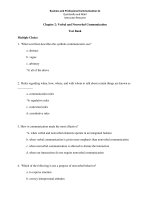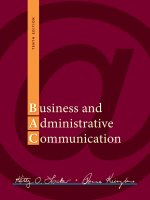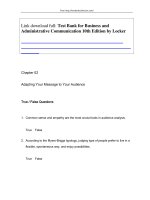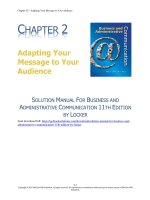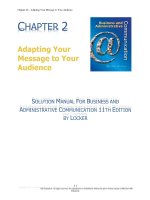Lecture Business and administrative communication: Chapter 18 - Kitty O. Locker, Donna S. Kienzler
Bạn đang xem bản rút gọn của tài liệu. Xem và tải ngay bản đầy đủ của tài liệu tại đây (614.66 KB, 14 trang )
Chapter 18
Analyzing Information
and Writing Reports
Copyright © 2015 McGrawHill Education. All rights reserved. No reproduction or distribution without the prior written consent of McGrawHill Education.
Chapter 18 Learning Objectives
LO 18-1 How to use your time efficiently when writing
reports
LO 18-2 How to analyze data, information, and logic
LO 18-3 How to choose information for reports
LO 18-4 How to organize reports
LO 18-5 How to present information effectively in
reports
LO 18-6 How to prepare the different components of
formal reports
182
Analyzing Data
Analyze gathered data so
report contains tight logic
Take data from reliable
sources
Analyze data with skepticism
Check to see data aligns with
expectations
Identify assumptions used in
analyzing data
183
Analyzing Data, continued…
Choosing the Best Data
Realize that good sources and authorities
can differ on
the numbers they offer
the interpretation of the same data
Understand
that conditions change over
time
184
Analyzing Data, continued…
Analyze numbers
Find mean, median, and range
Simplify if fitting: round off, combine
similar units
Chart data to see patterns
Compare to context to
create meaning
185
Analyzing Data, continued…
Analyzing patterns
Look for patterns—points of agreement
Have things changed over time?
Does geography account for differences?
Do demographics account for differences?
What similarities and differences do you
see?
What confirms your hunches or surprises
you?
186
Analyzing Data, continued…
Checking your logic
State accurately what data show
Don’t confuse causation with correlation
Look for three causes and three realistic
solutions for each problem
Check identified ideas against reality
Make report useful whatever data show
187
Choosing Information
Use only what audience needs to make
decision
How much depends on audience
Supportive—be concise, direct
Neutral or skeptical—give reasons,
explanations
Use appendix for information not needed
as proof
188
Organizing Reports
1. Process
information before
presenting it to an audience
2. Divide voluminous
information into three to
seven categories
3. Work with the audience’s
expectations, not against
them
189
Report Organization Patterns
1.
2.
3.
4.
5.
6.
7.
8.
Compare and contrast
Problem-solution
Elimination of alternatives
SWOT Analysis
a. General to particular
b. Particular to general
Geographic or spatial
Functional
Chronological
1810
Types of Reports
Informative and closure
Recommendation
Summarize completed work or research that
does not result in action/recommendation
Evaluate two more alternatives and
recommend one of them
Justification
Recommend or justify a purchase,
investment, hiring, or change in policy
1811
Effective Report Writing
Use these four techniques:
1.
2.
3.
4.
Use clear, engaging writing
Keep repetition to a minimum
Introduce sources and visuals
Use forecasting, transitions,
topic sentences, and headings
to organize
1812
Formal Report Parts
1.
2.
3.
4.
5.
6.
Title Page
Letter or Memo of Transmittal
Table of Contents
List of Illustrations
Executive Summary
Introduction
1813
Formal Report Parts
Background or History
8. Body
9. Conclusions and Recommendations
10. Appendixes
7.
1814




